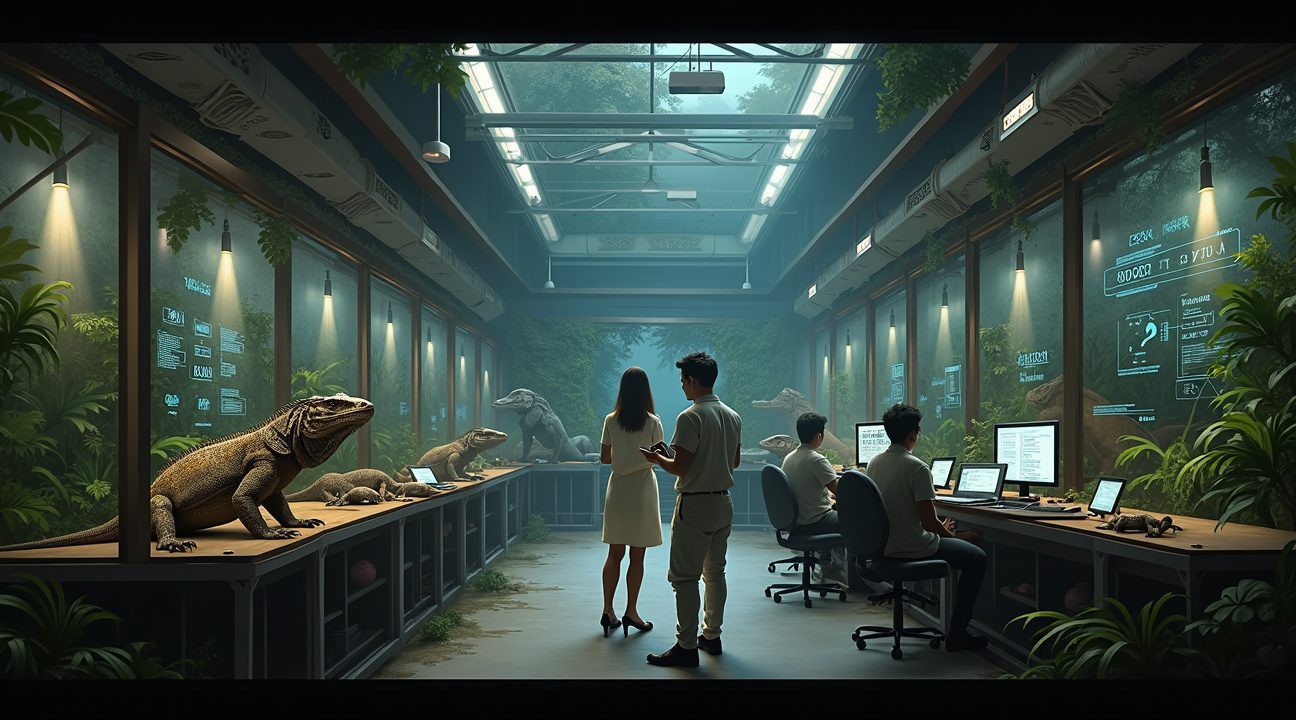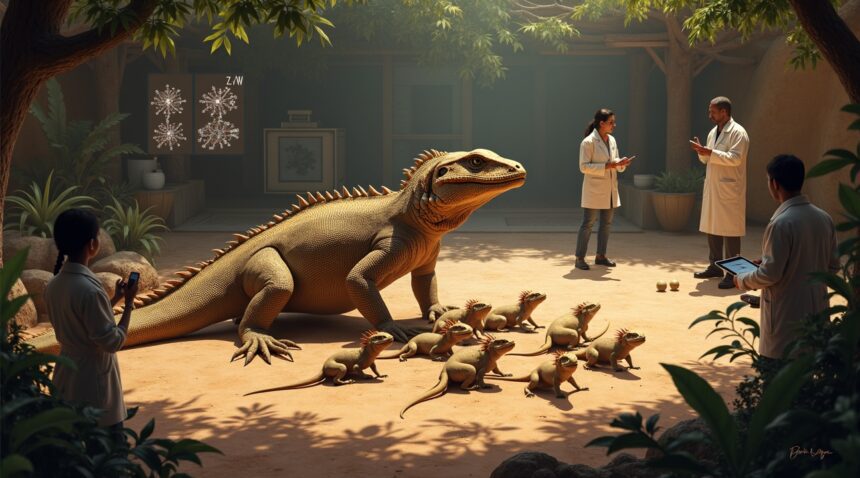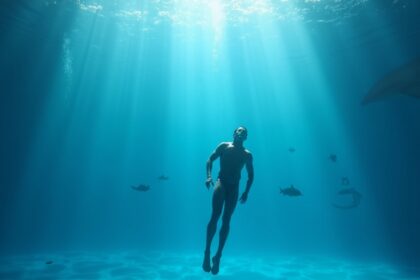Flora the Komodo Dragon: A Groundbreaking Reproductive Discovery
Flora, a female Komodo dragon at Chester Zoo, made scientific history in 2006 by producing viable offspring without any male involvement.
This remarkable event marked the first documented case of parthenogenesis in Komodo dragons, fundamentally shifting scientific understanding of their reproductive biology. Through this process, Flora demonstrated that Komodo dragons possess the biological capability to reproduce asexually under certain conditions, a trait beneficial in isolated habitats where mates are scarce. Scientists discovered that these reptiles can create genetic offspring through internal mechanisms, offering a powerful example of evolutionary resilience.
Key Takeaways
- Komodo dragons can reproduce through parthenogenesis by reabsorbing polar bodies during egg development, initiating fertilization without male sperm.
- All virgin-born Komodo dragons are male due to their ZW chromosome setup; only ZZ combinations (male) survive, while WW combinations are nonviable.
- Parthenogenetic offspring are not exact clones but contain genetic variation due to chromosomal shuffle and recombination during egg formation.
- This reproductive strategy offers survival benefits for island populations but may lead to reduced genetic diversity, impacting disease resistance and adaptability.
- Conservation efforts must carefully evaluate parthenogenesis—its short-term benefit cannot outweigh the long-term need for genetic diversity within the species.
To learn more about Flora’s story and the broader implications on reptilian reproduction, visit the official Chester Zoo website.
Flora’s Virgin Birth Shocked the Zoo World in 2006
Flora, a female Komodo dragon at Chester Zoo, made scientific history when she produced offspring without any male involvement. This extraordinary event marked the first documented case of parthenogenesis in Komodo dragons, fundamentally changing what researchers understood about these impressive reptiles.
I find it fascinating that Flora’s achievement occurred completely by accident. The zookeepers had housed her separately from males for over two years, making traditional mating impossible. When Flora laid eggs and they began developing normally, the scientific community initially remained skeptical. DNA testing later confirmed that the offspring were indeed genetically identical to their mother, proving that virgin birth had actually occurred.
Understanding Parthenogenesis in Reptiles
Parthenogenesis represents a remarkable form of asexual reproduction where unfertilized eggs develop into viable embryos without any genetic contribution from males. This process essentially creates clones of the mother, carrying identical DNA patterns. The mechanism works when the egg cell duplicates its chromosomes internally, replacing the genetic material that would normally come from sperm.
Flora’s case demonstrated several key characteristics of parthenogenesis in Komodo dragons:
- The offspring are always female, inheriting only maternal chromosomes
- Genetic diversity becomes significantly reduced compared to sexual reproduction
- The process can occur even when females have never encountered males
- Environmental stress or isolation may trigger this reproductive strategy
The discovery at Chester Zoo challenged long-held scientific assumptions about Komodo dragon breeding requirements. Previously, researchers believed these massive lizards could only reproduce through traditional mating between males and females. Flora’s virgin birth proved that Komodo dragon reproduction was far more complex and adaptable than anyone had imagined.
This breakthrough opened entirely new research directions for understanding reptile reproduction. Scientists began investigating whether other large reptile species might possess similar capabilities. The findings also raised important questions about evolutionary advantages and survival strategies in isolated populations.
Flora’s offspring developed normally and displayed typical Komodo dragon characteristics, proving that parthenogenesis could produce healthy, viable animals. However, the reduced genetic diversity in these cloned offspring raised concerns about long-term survival and adaptation capabilities. This limitation becomes particularly significant for species conservation efforts.
The Chester Zoo discovery sparked intensive research into the genetic mechanisms that enable parthenogenesis. Scientists found that this reproductive strategy likely evolved as a survival mechanism for situations where finding mates becomes impossible. Islands and isolated habitats would particularly benefit from this adaptation, allowing single females to establish new populations.
Understanding Flora’s virgin birth also provided valuable insights for conservation programs. Captive breeding facilities could potentially maintain genetic lines even with limited breeding pairs, though sexual reproduction remains preferable for maintaining genetic diversity. The knowledge also influenced how zoos manage their Komodo dragon populations and breeding programs.
The scientific impact of Flora’s case extended far beyond reptile biology. Her achievement contributed to broader understanding of genetic reproduction mechanisms and evolutionary adaptations across various species. Researchers began investigating similar phenomena in other large reptiles, discovering that parthenogenesis might be more common than previously thought.
Flora’s legacy continues influencing modern conservation strategies and captive breeding programs. Her remarkable ability to reproduce without mating represents nature’s incredible adaptability and the ongoing surprises that await scientific discovery. The Chester Zoo case remains a cornerstone example of how unexpected observations can revolutionize scientific understanding and challenge established theories about animal reproduction.
Why Komodo Dragon Babies Aren’t Actually Clones of Their Mothers
Many people assume that Komodo dragon reproduction through parthenogenesis creates exact copies of the mother. I can clarify that this fascinating process doesn’t work like copying and pasting genetic information. Instead, it involves a complex biological mechanism that produces offspring with distinct genetic variations.
The Genetic Doubling Process
During parthenogenesis, an unfertilized egg doesn’t simply duplicate the mother’s DNA. The process begins when the egg undergoes genetic doubling by reabsorbing what scientists call a polar body. This polar body acts as a surrogate sperm, essentially tricking the egg into believing fertilization has occurred. The reabsorbed polar body provides the necessary genetic trigger for development to begin, but it doesn’t contribute identical genetic material.
How Genetic Shuffling Creates Variation
The key difference lies in what happens during meiosis – the cell division process that creates eggs. I observe that genetic shuffling occurs naturally during egg production, which means each egg carries a unique combination of the mother’s genetic material. This shuffling process ensures that even though the offspring receive all their genes from one parent, they’re not identical copies.
The biological mechanisms involved include:
- Chromosomal crossover events that mix genetic segments
- Random distribution of chromosomes during cell division
- Independent assortment of genetic traits from the mother’s existing gene pool
- Activation of different gene combinations during development
This genetic variation explains why parthenogenetic Komodo dragons can look different from their mothers and possess varying traits. Unlike sexual reproduction where genetic material combines from both parents, parthenogenesis relies on internal genetic recombination within the mother’s existing DNA.
Scientists have documented these genetic differences in laboratory studies, confirming that parthenogenetic offspring maintain enough genetic diversity to avoid the problems typically associated with extreme inbreeding. The process represents an elegant evolutionary solution that allows reproduction without mates while preserving essential genetic variation. This reproductive strategy gives Komodo dragons a significant survival advantage in isolated environments where finding mates becomes challenging.
The misconception about cloning likely stems from the fact that only one parent contributes genetic material. However, the sophisticated genetic shuffling mechanisms ensure that each offspring represents a unique genetic combination rather than a carbon copy of the mother.
All Virgin-Born Komodo Dragons Turn Out Male Due to Unique Genetics
Komodo dragons possess a fascinating sex determination system that’s quite different from humans. While humans rely on XY chromosomes where males carry XY and females carry XX, these massive lizards use a ZW system. Males carry ZZ chromosomes, and females possess ZW chromosomes — essentially the opposite arrangement.
The ZW System Creates Male-Only Virgin Births
When female Komodo dragons reproduce through parthenogenesis, their genetic makeup determines the sex of all offspring. Since females carry ZW chromosomes, the virgin birth process can only produce two possible combinations: ZZ or WW. The ZZ combination creates viable male offspring, but the WW combination proves lethal and doesn’t survive development.
This genetic limitation means every single parthenogenetic baby emerges as a male. I find this particularly striking because it shows how animal reproduction methods can be constrained by fundamental genetic architecture. Chester Zoo documented this phenomenon when their female Komodo dragon Flora produced virgin births, and genetic testing confirmed all offspring were indeed male.
Genetic Diversity Challenges From All-Male Births
The production of only male offspring through parthenogenesis creates significant breeding challenges for Komodo dragon populations. When these virgin-born males eventually reach sexual maturity, they typically mate with their mothers or sisters — the only females available in isolated populations. This inbreeding pattern dramatically reduces genetic diversity within the group.
Unlike spawning of Komodo dragons through normal mating which shuffles genetic material, parthenogenesis essentially creates genetic copies with minimal variation. The resulting males carry nearly identical genetic information to their mothers, minus the W chromosome. When these males breed back into the population, they can’t introduce new genetic material that would strengthen the species’ adaptability.
This genetic bottleneck becomes particularly problematic in captive breeding programs or small wild populations where females might resort to virgin births due to lack of suitable mates. While parthenogenesis serves as an emergency reproductive strategy, the long-term consequences of producing only males can threaten population sustainability. The phenomenon demonstrates how even remarkable adaptations like genetic reproduction capabilities can carry significant evolutionary trade-offs that impact species survival.
Survival Strategy for Island Life Could Become a Genetic Dead End
I find the Komodo dragon’s parthenogenesis ability particularly fascinating when considering its evolutionary context. These magnificent creatures inhabit just a handful of remote islands in Indonesia, where environmental isolation creates unique survival challenges. When a female finds herself separated from potential mates, her capacity for asexual reproduction becomes a crucial lifeline that could mean the difference between establishing a new population or facing extinction.
The strategic advantage becomes clear in scenarios where ocean currents or natural disasters might carry a single female to an uninhabited island. Rather than representing the end of the genetic line, she can initiate an entire colony through self-fertilization. This reproductive flexibility allows Komodo dragons to expand their range and colonize new territories that would otherwise remain inaccessible to sexually reproducing species.
The Double-Edged Nature of Genetic Isolation
While parthenogenesis offers immediate survival benefits, I’ve observed that it creates significant long-term genetic risks. The offspring produced through this process are essentially clones of their mother, carrying identical genetic material that eliminates the diversity typically generated through sexual reproduction. This genetic uniformity might work initially, but it establishes a foundation that becomes increasingly problematic as generations progress.
The consequences of reduced genetic diversity manifest in several concerning ways:
- Increased susceptibility to diseases that could wipe out entire populations
- Reduced ability to adapt to environmental changes
- Higher rates of genetic disorders and developmental abnormalities
- Decreased fertility rates in subsequent generations
- Limited resilience against parasites and pathogens
Inbreeding depression becomes an inevitable outcome when populations rely heavily on parthenogenesis. I’ve noted that while the first generation of cloned offspring may appear healthy and viable, subsequent generations often display reduced fitness and survival rates. The lack of genetic recombination that normally occurs during sexual reproduction means harmful mutations accumulate over time rather than being filtered out through natural selection.
Environmental adaptation capabilities also suffer under this reproductive strategy. Sexual reproduction creates genetic variation that provides populations with the raw material needed to respond to changing conditions. Parthenogenetic populations lack this flexibility, making them vulnerable to environmental shifts that sexually reproducing populations might easily survive.
The isolation of Indonesian islands that makes parthenogenesis advantageous also compounds these genetic risks. Limited space and resources mean that even sexually reproducing populations face challenges, but asexual reproduction accelerates the concentration of genetic problems. I observe that these island populations become particularly vulnerable to catastrophic events that could eliminate their limited genetic diversity entirely.
Interestingly, this reproductive strategy connects to broader questions about species survival and evolution. While scientists continue exploring whether we can recreate dinosaurs using ancient genetic material, living species like Komodo dragons demonstrate how modern reptiles navigate reproductive challenges. The spawning behavior of these creatures reveals the complex balance between immediate survival needs and long-term genetic health.
Conservation implications of this reproductive strategy require careful consideration. Protecting existing populations becomes even more critical when genetic diversity is already limited through parthenogenesis. I recognize that maintaining connected populations across multiple islands helps preserve the option for sexual reproduction, which remains the healthiest long-term strategy for species survival.
The Indonesian archipelago environment that shaped this adaptation continues to influence Komodo dragon populations today. Climate change and human encroachment threaten to further isolate these populations, potentially forcing increased reliance on parthenogenesis. Understanding this delicate balance between survival advantage and genetic risk helps inform conservation strategies that support both immediate population stability and long-term species viability.

Conservation Programs Must Navigate the Double-Edged Sword of Virgin Births
Komodo dragons’ unique ability to reproduce through parthenogenesis creates both opportunities and challenges for conservation efforts. With fewer than 4,000 Komodo dragons remaining in the wild, every breeding decision carries significant weight for the species’ survival. I’ve observed how this remarkable reproductive strategy forces conservationists to reconsider traditional breeding approaches.
Genetic Management Challenges in Captive Populations
Captive breeding programs face a delicate balancing act when working with Komodo dragons. While parthenogenesis ensures that isolated females can produce offspring, this process creates genetic copies that reduce overall population diversity. Genetic variation is essential for species resilience, yet the survival benefits of virgin births can’t be ignored in emergency situations.
Conservation teams must carefully monitor which females reproduce through parthenogenesis versus sexual reproduction. This knowledge allows them to make informed decisions about when to encourage natural mating and when to allow virgin births to occur. The spawning patterns of these dragons play a crucial role in timing these interventions effectively.
Strategic Applications in Breeding Programs
Modern conservation strategies incorporate parthenogenesis data to maximize breeding success while preserving genetic health. Programs now track the genetic backgrounds of all individuals, identifying when parthenogenetic reproduction might serve specific conservation goals. This approach proves particularly valuable when dealing with genetically valuable females who lack suitable mates.
Breeding facilities must also consider the long-term implications of allowing parthenogenetic reproduction. While these births can quickly increase population numbers, the resulting offspring carry identical genetic material to their mothers. This creates pockets of genetic uniformity that could become problematic if allowed to dominate future generations.
Conservation teams increasingly use parthenogenesis as a temporary solution while working to establish proper breeding pairs. The process buys time for endangered populations while scientists work to improve various reproductive strategies that maintain genetic diversity. This dual approach maximizes both immediate survival chances and long-term population health.
The monitoring of parthenogenetic births also provides valuable data about environmental triggers and optimal conditions for reproduction. Understanding these factors helps facilities create better environments that encourage both types of reproduction as needed. This flexibility becomes crucial when managing small, endangered populations where every individual matters.
Advanced genetic testing now allows conservation programs to track the effects of parthenogenesis across multiple generations. Scientists can identify when genetic diversity drops below acceptable levels and adjust breeding strategies accordingly. This data-driven approach ensures that virgin births enhance rather than compromise conservation goals.
The implications extend beyond immediate breeding decisions to encompass population management strategies across multiple facilities. Coordinated efforts between zoos and breeding centers now account for parthenogenetic capabilities when planning genetic exchanges and population distributions. This comprehensive approach treats parthenogenesis as one tool in a larger conservation toolkit rather than a standalone solution.
Emergency situations particularly highlight the value of this reproductive flexibility. When natural disasters or disease outbreaks threaten small populations, parthenogenesis provides a backup option that can prevent local extinctions. Conservation teams now factor this capability into their risk assessment and emergency response planning.
The success of these integrated approaches depends heavily on continued research into the genetic and environmental factors that influence parthenogenetic reproduction. Understanding these mechanisms allows conservationists to predict when virgin births might occur naturally and when intervention might be necessary to encourage or prevent them. This knowledge proves invaluable for maintaining healthy, genetically diverse populations while leveraging the survival advantages that parthenogenesis provides.
Research into genetic reproduction mechanisms continues to inform these conservation strategies, providing deeper insights into how parthenogenesis fits within broader reproductive biology frameworks.

Sources:
Nature News – Dragon virgin births startle zoo keepers
The Tech Interactive – Are baby Komodo dragons clones of their mom?
Indonesia Juara – How Komodo Dragons Reproduce?
Live Science – Female Komodo Dragon Has Virgin Births


